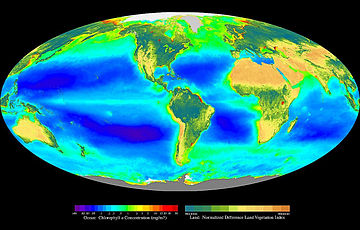
Biosphere
Background to the schools Wikipedia
This wikipedia selection has been chosen by volunteers helping SOS Children from Wikipedia for this Wikipedia Selection for schools. Do you want to know about sponsoring? See www.sponsorachild.org.uk

Our biosphere is the global sum of all ecosystems. It can also be called the zone of life on Earth, a closed (apart from solar and cosmic radiation) and self-regulating system. From the broadest biophysiological point of view, the biosphere is the global ecological system integrating all living beings and their relationships, including their interaction with the elements of the lithosphere, hydrosphere and atmosphere. The biosphere is postulated to have evolved, beginning through a process of biogenesis or biopoesis, at least some 3.5 billion years ago.
In a broader sense; biospheres are any closed, self-regulating systems containing ecosystems; including artificial ones such as Biosphere 2 and BIOS-3; and, potentially, ones on other planets or moons.
Origin and use of the term
The term "biosphere" was coined by geologist Eduard Suess in 1875, which he defined as:
"The place on Earth's surface where life dwells."
While this concept has a geological origin, it is an indication of the impact of both Darwin and Maury on the earth sciences. The biosphere's ecological context comes from the 1920s (see Vladimir I. Vernadsky), preceding the 1935 introduction of the term " ecosystem" by Sir Arthur Tansley (see ecology history). Vernadsky defined ecology as the science of the biosphere. It is an interdisciplinary concept for integrating astronomy, geophysics, meteorology, biogeography, evolution, geology, geochemistry, hydrology and, generally speaking, all life and earth sciences.
Gaia hypothesis
The concept that the biosphere is itself a living organism, either actually or metaphorically, is known as the Gaia hypothesis.
James Lovelock, an atmospheric scientist from the United Kingdom, proposed the Gaia hypothesis to explain how biotic and abiotic factors interact in the biosphere. This hypothesis considers Earth itself a kind of living organism. Its atmosphere, geosphere, and hydrosphere are cooperating systems that yield a biosphere full of life. In the early 1970s, Lynn Margulis, a microbiologist from the United States, added to the hypothesis, specifically noting the ties between the biosphere and other Earth systems. For example, when carbon dioxide levels increase in the atmosphere, plants grow more quickly. As their growth continues, they remove more and more carbon dioxide from the atmosphere.
Many scientists are now involved in new fields of study that examine interactions between biotic and abiotic factors in the biosphere, such as geobiology and geomicrobiology.
Ecosystems occur when communities and their physical environment work together as a system. The difference between this and a biosphere is simple, the biosphere is everything in general terms.
Extent of Earth's biosphere

Every part of the planet, from the polar ice caps to the Equator, supports life of some kind. Recent advances in microbiology have demonstrated that microbes live deep beneath the Earth's terrestrial surface, and that the total mass of microbial life in so-called "uninhabitable zones" may, in biomass, exceed all animal and plant life on the surface. The actual thickness of the biosphere on earth is difficult to measure. Birds typically fly at altitudes of 650 to 1,800 meters, and fish that live deep underwater can be found down to -8,372 meters in the Puerto Rico Trench.
There are more extreme examples for life on the planet: Rüppell's Vulture has been found at altitudes of 11,300 meters; Bar-headed Geese migrate at altitudes of at least 8,300 meters (over Mount Everest); Yaks live at elevations between 3,200 to 5,400 meters above sea level; mountain goats live up to 3,050 meters. Herbivorous animals at these elevations depend on lichens, grasses, and herbs.
Microscopic organisms live at such extremes that, taking them into consideration puts the thickness of the biosphere much greater. Culturable microbes have been found in the Earth's upper atmosphere as high as 41 km (25 mi) (Wainwright et al., 2003, in FEMS Microbiology Letters). It is unlikely, however, that microbes are active at such altitudes, where temperatures and air pressure are extremely low and ultraviolet radiation very high. More likely these microbes were brought into the upper atmosphere by winds or possibly volcanic eruptions. Barophilic marine microbes have been found at more than 10 km (6 mi) depth in the Marianas Trench (Takamia et al., 1997, in FEMS Microbiology Letters). Microbes are not limited to the air, water or the Earth's surface. Culturable thermophilic microbes have been extracted from cores drilled more than 5 km (3 mi) into the Earth's crust in Sweden (Gold, 1992, and Szewzyk, 1994, both in PNAS), from rocks between 65-75 °C. Temperature increases with increasing depth into the Earth's crust. The speed at which the temperature increases depends on many factors, including type of crust (continental vs. oceanic), rock type, geographic location, etc. The upper known limit of microbial is 122 °C ( Methanopyrus kandleri Strain 116), and it is likely that the limit of life in the "deep biosphere" is defined by temperature rather than absolute depth.
Our biosphere is divided into a number of biomes, inhabited by broadly similar flora and fauna. On land, biomes are separated primarily by latitude. Terrestrial biomes lying within the Arctic and Antarctic Circles are relatively barren of plant and animal life, while most of the more populous biomes lie near the equator. Terrestrial organisms in temperate and Arctic biomes have relatively small amounts of total biomass, smaller energy budgets, and display prominent adaptations to cold, including world-spanning migrations, social adaptations, homeothermy, estivation and multiple layers of insulation.
Specific biospheres
When the word is followed by a number, it is usually referring to a specific system or number. Thus:
- Biosphere 1, the planet Earth
- Biosphere 2, a laboratory in Arizona which contains 3.15 acres (13,000 m²) of closed ecosystem.
- BIOS-3, a closed ecosystem at the Institute of Biophysics in Krasnoyarsk, Siberia, in what was then the Soviet Union.
- Biosphere J (CEEF, Closed Ecology Experiment Facilities), a experiment in Japan.
